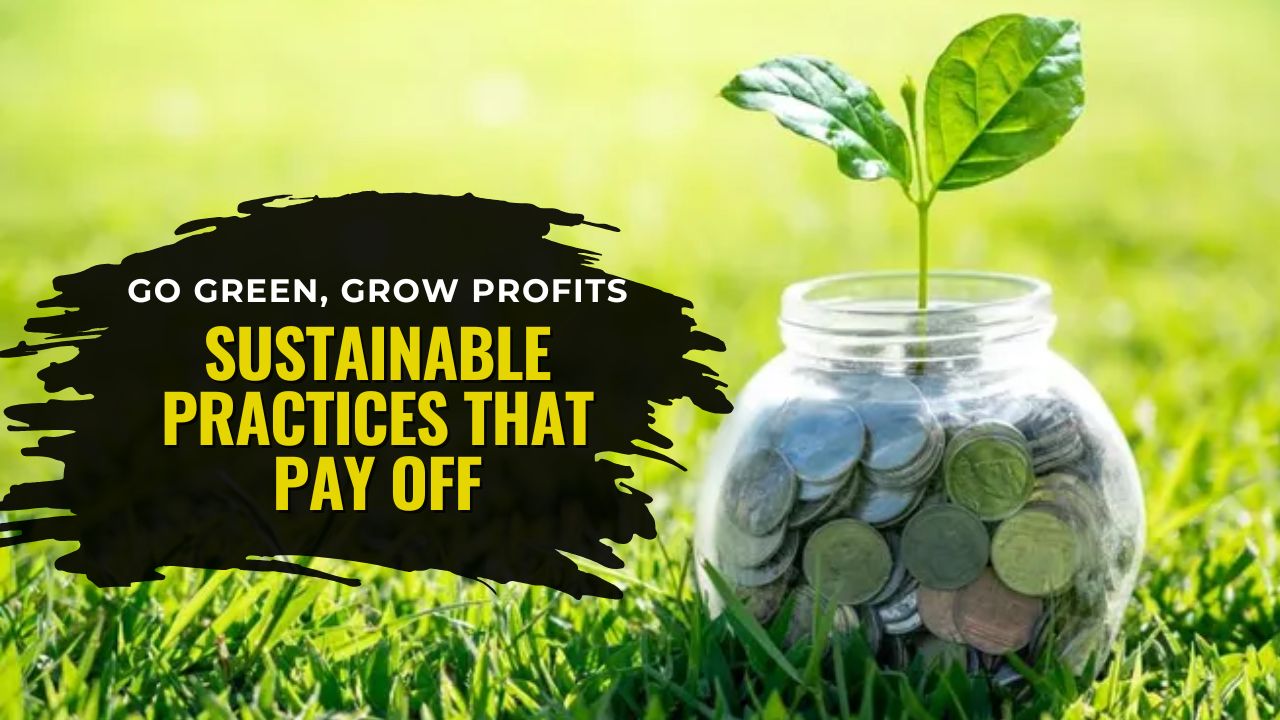In 2025, going green is not a cost burden—it is a competitive edge. Across industries, companies are discovering that sustainable practices can cut costs, generate new revenue, and mitigate risks.
Rather than compliance or marketing puffery, sustainability is becoming an essential part of corporate strategy.
As resource prices rise, climate risk intensifies, and stakeholder expectations shift, businesses that adopt sustainable operational practices are seeing real financial gains—better margins, lower volatility, stronger valuations, and improved brand loyalty.
Recent industry surveys show that a quarter of business leaders now cite increased profitability as a direct outcome of sustainability initiatives.
Others point to higher revenue growth and reduced regulatory or physical risk as primary benefits. In many enterprises, sustainability efforts contribute to 6–7 % higher valuation multiples compared to peers lacking a sustainability agenda.
The Core Profit Engines of Sustainable Practices
Let’s dig into the most powerful sustainable levers that actually pay off.
1. Dramatic Energy Efficiency Gains
Energy use is one of the biggest controllable expenses for many businesses. Upgrading lighting, optimizing HVAC, implementing building controls, and retrofitting efficient equipment yield high returns.
- LED lighting retrofits: Replacing old fluorescent or incandescent bulbs with LED can reduce lighting energy consumption by 50 to 90 %. Because the technology is mature, payback periods can be short—often 1 to 3 years.
- Smart lighting controls & occupancy sensors: Adding motion sensors, daylight tracking, and zone scheduling can further reduce waste by turning off lighting when unused.
- HVAC optimization & variable speed drives: Upgrading HVAC systems, retro-commissioning duct systems, and using variable frequency drives (VFDs) saves on both heating and cooling energy.
- Energy performance contracts: Some businesses use guaranteed-savings models, where third parties finance upgrades (lighting, HVAC, insulation) and get repaid from the energy savings, reducing upfront capital burden.
By combining these measures, many facilities cut total energy bills by 20–40% or more. The incremental savings feed directly to the bottom line.
2. Locking in Clean Power via Long-Term Contracts
A major innovation in corporate sustainability is having companies sign Power Purchase Agreements (PPAs) or Virtual PPAs (VPPAs) with renewable energy producers (e.g. solar, wind). These agreements fix a price per MWh for long tenors (10–20 years), stabilizing costs and hedging against electricity price volatility.
The benefits are twofold:
- You get a predictable energy cost for years ahead—even as grid prices fluctuate.
- These contracts make renewable projects more bankable because of guaranteed off-take, encouraging further investment in clean energy.
In 2025, many companies have already moved from pilot PPAs to portfolio-level deals. Some energy portfolios now bundle solar, wind, and battery storage under one long-term contract, sometimes covering a significant fraction of a company’s load.
These deals de-risk energy supply and help companies meet internal emission targets simultaneously.
3. Water Efficiency and Conservation
Water is often overlooked but can be a hidden drain on profits—especially in manufacturing, facilities, and agriculture.
Smart investments here yield direct cost savings and resilience in water-stressed regions.
Key strategies include:
- Leak detection and repair (pipes, valves, fittings)
- Upgrading to low-flow faucets, showers, and toilets
- Installing smart water meters and real-time monitoring
- Recycling and reuse of process water
- Stormwater capture and rainwater harvesting
In real cases, organizations have achieved 20–30 % or more reductions in water consumption, cutting utility bills significantly.
In water-scarce or regulated areas, reduced consumption also lowers risk from supply curtailment or regulatory penalties.
4. Waste Reduction & Circular Economy Practices
Reducing waste—both solid and material, including packaging and scrap—contributes in multiple ways:
- Lower disposal and handling costs
- Recover value via recycling, remanufacturing, or resale
- Reduce input costs by using recycled materials
- Improve brand image and meet circular-economy mandates
Companies that design for circularity (modular design, take-back programs, material reuse) not only reduce costs but often unlock new revenue streams—repairs, refurbishment, subscription models, leasing rather than selling.
5. Sustainable Procurement & Supplier Engagement
Your sustainability performance doesn’t just depend on your operations—it depends on your supply chain.
Engaging suppliers to reduce emissions, improve labor and environmental practices, and source low-impact materials creates leverage across your input base.
Firms that actively manage supplier sustainability often unlock:
- Lower supplier risk (disruptions, noncompliance)
- Innovation from eco-friendly materials or processes
- Efficiency gains across supply tiers
- Stronger bargaining position
Many businesses report that sustainability initiatives lead to 6–7 % higher enterprise valuations, thanks in part to supplier engagement, risk mitigation, and innovation.
Implementation Strategy: From Pilot to Scale
A thoughtful deployment strategy helps convert sustainability into lasting profit gains.
Step 1: Baseline Audit & Diagnostic
Start with robust audits of energy, water, waste, and supply chains. Identify the biggest inefficiencies and prioritize interventions with fastest payback or highest impact.
Step 2: Pilot & Quick Wins
Target low-hanging fruit first—LED retrofits, leak repair, controls upgrades. These projects often recycle capital quickly, supporting deeper investments later. Monitor results and validate assumptions.
Step 3: Capital Projects & Contracts
Once pilots prove value, scale to larger upgrades—HVAC, heat pumps, renewables, efficiency retrofits. Meanwhile, evaluate PPAs/VPPAs to lock in green energy. Use scenario modeling to compare contract outcomes vs grid tariffs.
Step 4: Supply Chain & Circular Programs
Roll out sustainable procurement policies, supplier training, circular design pilots, and waste reduction systems. Embed sustainability in sourcing decisions.
Step 5: Measurement, Reporting & Continuous Improvement
Track Key Performance Indicators (KPIs)—energy intensity, water per unit output, waste diversion rate, supplier emissions, cost savings. Use dashboards to manage performance and improvements. Tie these metrics to finance, operations, and executive goals.
Be rigorous: measure what you manage. As sustainability becomes embedded, build toward net zero or carbon neutrality goals.
Profit & Impact Snapshot: Key Metrics to Watch
| Area | Typical Savings / Impact | Business Benefits |
|---|---|---|
| LED & controls upgrades | 50–90 % reduction in lighting energy | Fast payback, lower maintenance, immediate margin uplift |
| HVAC & system optimization | 15–30 % energy reduction | Lower OPEX, better comfort, longer equipment life |
| Long-term PPAs / VPPAs | Stable, predictable energy cost | Protects margins, de-risks energy volatility |
| Water efficiency | 20–30 % usage cut | Reduces utility bills and risk in water-stressed zones |
| Waste & circularity | Up to 20–40 % less waste | Lower disposal costs, recover materials, new revenue lines |
| Supplier sustainability | 6–7 % uplift in valuations | Reduced risk, innovation, more resilient supply chain |
Real-World Evidence That Green Pays
- Some industrial firms deploying rooftop solar and wind on multiple sites report internal rates of return (IRR) above 20 % over 10–25 years, with payback in under 5 years in many cases.
- In some manufacturing portfolios, LED and HVAC upgrades delivered energy cost reductions of 25–35 %.
- Sustainable procurement programs have gained traction: companies report better valuations, lower supplier risk, and innovation leverage.
- Renewable energy adoption is accelerating: in many markets, renewables now supply a substantial portion of power demand, making PPAs more attractive.
- Investors are increasingly valuing firms with strong ESG metrics more favorably, reducing cost of capital and raising valuations.
These cases underscore that sustainable practices are not just ethical—they can be central to financial strategy.
Risks, Challenges & Mitigation
While the benefits are strong, sustainable transformation faces obstacles:
- Upfront capital needs: Capex for retrofits, renewable installations, and new systems may be high. Mitigate via performance contracts, leasing, or green finance.
- Data and measurement gaps: Many firms lack robust systems to track energy, water, and waste accurately. Invest in metering, sensors, and analytics platforms.
- Change management resistance: Operations teams may resist new technologies. Engage stakeholders early, train staff, and build incentives.
- Supply chain complexity: Smaller suppliers may struggle with standards. Provide support, phased plans, and capacity building.
- Regulatory and policy uncertainty: Incentives, subsidies, or energy policies may change. Mitigate by diversifying renewable contracts and maintaining flexibility.
With proper planning and governance, these challenges can be addressed, turning barriers into opportunities.
Roadmap to Get Started (6-Step Checklist)
- Set leadership commitment & strategy — Align sustainability goals with business goals and get executive sponsorship.
- Conduct comprehensive audits — Cover energy, water, waste, supply chain, and material usage.
- Prioritize quick wins — LED retrofits, leak fixes, control systems. Validate ROI with real data.
- Model and execute larger projects — HVAC upgrades, heat pumps, solar, battery storage, long-term energy contracts.
- Engage suppliers — Set sustainability criteria, provide training, pilot circular models.
- Track, report, iterate — Develop dashboards, tie metrics to bonuses, continuously refine programs.
Over time, sustainability becomes part of your core operations—not a side activity.
“Going green” is no longer a vague aspiration—it is a proven pathway to grow profits.
In 2025, companies that strategically invest in energy efficiency, renewable energy contracts, water and waste savings, and supply chain sustainability are reaping powerful financial gains.
These gains come through lower operating expenses, stabilized energy costs, improved valuation, and risk mitigation.
Start with low-hanging fruit, build credibility through measurement, and scale to complex projects.
Embed sustainability into your business DNA—and you’ll find it doesn’t just save money, it helps you earn more, compete better, and future-proof your enterprise.
FAQs
Which sustainable upgrade pays back fastest?
LED lighting and sensor-based control upgrades are usually the fastest ROI moves. Because LED technology is mature and drop-in compatible, lighting energy often drops by 50–90 %, delivering paybacks within 1 to 3 years.
Are renewable energy contracts (PPAs / VPPAs) worth it?
Yes. These contracts let you lock in fixed renewable energy prices for 10–20 years, hedging against grid price volatility. They also strengthen the business case for new clean energy projects, creating mutual value for the buyer and the developer.
How can I make sustainability measureable and tied to profit?
Use robust KPIs—energy intensity (kWh per unit output), water per unit, waste diversion rate, supplier emissions, cost savings. Link these to dashboards, financial reporting, and operational goals. Always validate actual savings (not estimates) and reinvest returns into further sustainable upgrades.

